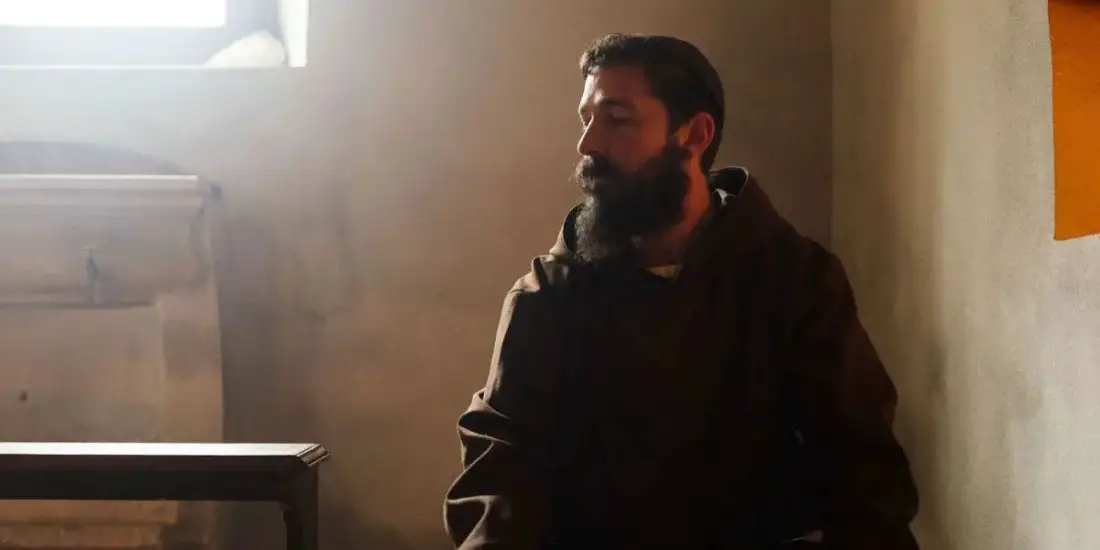‘Padre Pio’ Review: “A Biopic for False Reconciliation”

Whether you appreciate his filmography or not, cinephiles worldwide must admit that Abel Ferrara is an iconic filmmaker. He’s a legend in the New York independent and exploitation scene. From King of New York to The Addiction, he has offered us some fascinating artsy tales. It is pretty impressive that the seventy-one-year-old director continues to have the urge to make films. Ferrara is constantly offering a different experience each time around. Padre Pio, his latest work is a larger-scale project in comparison to his most recent work. He divides the film into a biopic and a tale of post-war political corruption. But, unfortunately, it turns out to be the worst film of his career, led by Shia LaBeouf, who delivers an unconvincing performance as the titular saint.
Padre Pio begins with a whispered voiceover by the titular priest (LaBeouf), backed by a way-too-loud piano score that almost makes it hard to hear what the character says. During those moments, he talks to a higher power about suffering and reconciliation. He hopes it will provide him strength and courage for what will transpire during the film’s events. Upon his arrival, Pio is welcomed by a fellow monk after his long journey across the Italian plains. Ferrara then transitions that scene into one where families greet their men returning from war. The interlacing between these two scenes shows the dual-perspective structure the film will be using. Both sides focus on how suffering injures people’s souls and the spark of revolution amidst great (personal and communal) tragedy.
After such a series of events, an embodiment of the devil – a black-suited man with a raspy voice – speaks to Padre Pio. The devil wants Pio to feel remorseful about skipping war – calling him a coward and narcissistic. Pio is being torn on the inside by his words. He yells at him, “You say Christ is Lord,” repeatedly. And the fiend figure, which seems to take many forms (including a dog and a shadow at one point), beats him up. This vision has haunted Pio, leaving him sleepless and worry-full. That specific scene causes a tonal shift in the film since what we have seen beforehand felt grounded. At first, it takes you by surprise. You feel like it will take a similar approach to Lars von Trier’s The House that Jack Built, although without the self-reflective and darker tone.
READ: The ‘Ted Lasso’ Finale Leaves Everyone Where They Should Be
As the runtime passes, there are a few more scenes like this, and it begins to bother the viewer. These scenes are meant to explore the spiritual and mental struggle Saint Pio of Pietrelcina had during a post-WWII world. It was a time when everybody was in a state of grieving flux. Some people depended on religion for help, while others made their own movements. They did all of this to eliminate that sensation of dread and suffering that had been lingering in their heads for the past couple of years. In addition, it helps soothe their worries about the future. In Padre Pio, these two sides are seen via a loose narrative structure that follows a couple of plot threads.
The issue is that there’s nearly zero detail to these concepts. Ferrara relies on arthouse imagery, which isn’t well-shot or pieced together properly to begin with, to fill the missing gaps in the screenplay. The supposedly spiritual experience Ferrara wants to take you in is unengaging due to the ridiculous, quite baffling executed scenes. There are plenty of head-scratching decisions, both in front and behind the camera. This causes Padre Pio to quickly lose sense of the plot and its intentions. You see this a lot with plenty of filmmakers from that era who continue to make films today.
Ferrara’s array of Willem Dafoe-starring films, particularly Pasolini and 4:44 Last Day on Earth, contain plenty of ideas and concepts that shouldn’t work. The latter half of his filmography includes some of his most daring and ambitious turns as a director. Even if it ends up as a divisive project, his daring choices don’t serve the role of being a gimmick or half-witted storytelling device. The opposite translates to this half-period piece half-biopic. The central gimmicks in Padre Pio are LaBeouf’s performance, the out-of-place narrative structure, alongside the array of inexplicable scenes of the titular character’s visions.
What does Pio’s vision of a naked French woman kissing the iconography have to do with his journey that leads to a closing stigmata? Aside from being a moment that alludes to Abel Ferrara’s exploitation cinema background, that sequence doesn’t make any sense. I love that Ferrara continues to make one bold film after another, even if it doesn’t end up gelling altogether. But with his latest, he has reached a point of no return. – Hector Gonzalez
Rating: 3/10
Padre Pio is now playing in select theaters and is available on VOD.
—–
Did you like this article? If so, consider visiting our YouTube channel, where we discuss the latest and greatest in pop culture news.





